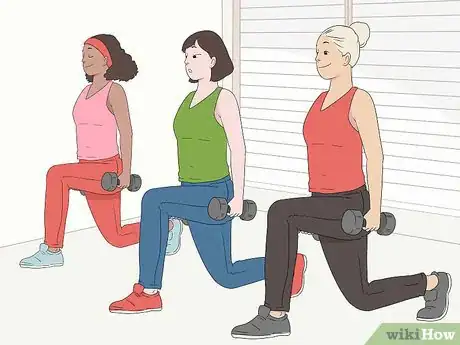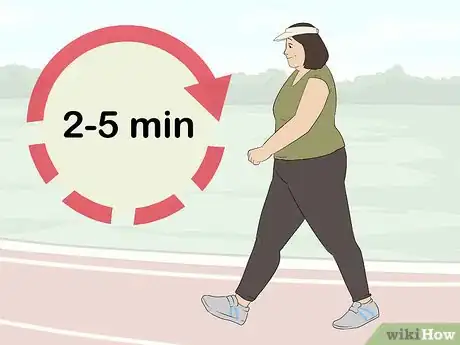This article was co-authored by Francisco Gomez. Francisco Gomez is the Head Coach at the FIT Potato Gym, a training gym established in 2001 in the San Francisco Bay Area. Francisco is a former competitive runner who helps endurance athletes train for major marathons like the Boston Marathon. Francisco specializes in Injury Rehab, Flexibility, Marathon Training, and Senior Fitness. He has a B.S. in Nutrition and Exercise Physiology & Running.
There are 12 references cited in this article, which can be found at the bottom of the page.
wikiHow marks an article as reader-approved once it receives enough positive feedback. In this case, 100% of readers who voted found the article helpful, earning it our reader-approved status.
This article has been viewed 107,385 times.
Whether you’re getting back to exercise after a chronic disease flare-up or getting physical after a long illness, exercise – when done appropriately – can help your body to heal faster and feel better.[1] It’s important to recognize your limitations and increase your activity gradually to avoid injury, but with patience and perseverance you can get back to your previous state of fitness and health. Work with your doctor, be patient, and take your specific health needs into consideration, and you’ll be able to resume or start a fitness program.
Steps
Making a Plan
-
1Consult your doctor. The best thing you can do when returning to exercise after being sick is to talk to your doctor about it.[2] Depending on your illness there are probably specific things to work on and avoid. Know the effects of any medications you’re taking – like if you’re more likely to become dehydrated while exercising. Your doctor may refer you to a Physical Therapist or Occupational Therapist for professional help getting moving, depending on your needs.
- Say something to your doctor like, “Now that I’m feeling better I want to start a fitness regime. Can you help me make a safe plan?”
- Call your doctor immediately if you experience any of the following during exercise: chest pain or tightness, shortness of breath or difficulty breathing, nausea or vomiting, irregular heartbeat, numbness in your arms, lightheadedness, faintness, you pass out, or start to sweat profusely (more than would be expected for your activity level).[3]
-
2Acknowledge that you’re starting over. No matter how fit you were before your illness, being sick for a while takes a toll on your body. Your muscles are weaker than before and your stamina and endurance will be lower. This is normal! Acknowledge that you’re basically starting over, like it’s your first time exercising. Prepare yourself mentally to start slow, increase your activity gradually, and be patient.[4] Remember that you can and will get fit, it just takes time.
- If you start lifting heavy weights right away, there’s a chance that your weakened muscles will get a tear, sprain, or strain.[5]
- You have to rebuild your cardiovascular fitness, i.e. endurance. It’s likely your heart rate will elevate more easily now that you’ve been inactive for a while.
- Your immune system has been fighting hard to overcome your illness, so if you overwork your body you’ll probably feel unwell the next day.[6] Take it easy to avoid getting symptoms again.
Advertisement -
3Plan ahead and make goals. What do you want to be able to do again – run a marathon, go back to aerobics class, play a sport? If you make goals and write them down, you're more likely to achieve them.[7]
- Keep a workout journal to help you stay motivated. Write down your main goal, and then smaller goals for one week, two weeks, and one month. For instance, if your main goal is, “Run a marathon in a year,” don’t expect to start running 10 miles this week. Increase your goals gradually, starting with something like “Week 1: Walk for 30 minutes a day” and working up to “6 months: Run 10 miles 2-3 times per week.” Start as big or as small as is safe and comfortable for you.
- Be realistic and specific in your goals.[8] “Walk 30 minutes a day” is more specific and motivating than “do some walking.” Write down your accomplishments to see how far you’ve come.
-
4Stay motivated by working with a group. Getting acclimated to your fitness routine after an illness can be challenging. Try working out with a friend or family member to help you stay motivated and safe. Some hospitals, clinics, and health clubs sponsor exercise programs for patients with specific conditions – ask your doctor about availability and consider joining up so you have support.[9]
Exercising Safely and Effectively
-
1Stay hydrated while exercising.[10] Drink plenty of fluids to help your body sweat and maintain a normal body temperature, so you avoid heat stress and dehydration. Take a break every 20 minutes during exercise to drink some water, even if you don’t feel thirsty.[11]
- If your doctor has told you to limit fluids because of a health condition, be sure to ask them about staying hydrated during fitness activities.
- Some medications affect your body's ability to stay hydrated and cool, such as some to treat high blood pressure and heart problems (beta blockers, diuretics), allergy symptoms (antihistamines), anxiety (tranquilizers), and psychiatric symptoms such as delusions (antipsychotics).[12]
-
2Start your fitness regime with walking. Walking is one of the safest activities to get your muscles and joints used to being active again. Take a walk every day, and don’t worry if you start slowly – even 5 minutes is a good start. Try to increase how far you walk every day.
- Get an inexpensive pedometer to measure how many steps you take. The goal for healthy adults is 10,000 steps every day.[13] From whatever is your starting point, try to increase it 500 steps more every day until you can do 10,000 steps with no pain or discomfort.
-
3Listen to your body. If a 30 minute walk leaves you feeling exhausted, that’s okay! Cut it down to 15 minutes until that feels comfortable, then increase it. Everyone recovers at different speeds. Push yourself to be slightly outside your comfort zone, without being in pain or having symptoms return.
- If you’ve had a severe illness, even walking may seem like a challenge. The idea is to start small, even extremely small, like getting up to use the bathroom or make a meal. Then slowly and gradually increase your activity each day.
-
4Begin your regime with a warm-up. Even at the best of times, do not jump into full workout mode without a warm-up. This is especially important now that you’re rebuilding strength and endurance. Start each fitness regime with at least 2-3 minutes of warm-up exercises like shoulder shrugs, toe taps, marching in place, knee lifts or leg lifts, and lifting your arms over your head.[14]
-
5Include stretching or flexibility exercises in your routine. Flexibility is an important part of overall fitness, just like strength and endurance.[15] Start your day with 10-15 minutes of stretching.[16] Breathe slowly and deeply while your stretch, and hold each stretch for at least 30 seconds.
- Try to get one of the many phone apps that lead you through various stretches, like Stretching Programs for Android or Stretching Sworkit for iPhone.
- When you’re ready, you can also replace one or two of your weekly workouts with an easy to moderate yoga session, which both stretches and gently strengthens muscles.
-
6Increase your cardio. Once you’ve eased back into activity, start working on cardio exercises. Leave strength training for later. Do aerobic exercises like jogging, swimming, the elliptical machine, bike riding – whatever increases your heart rate and breathing rate and gets you to break a sweat.[17]
- When you’re ready to work on cardio, aim to do 50% of your pre-sickness activity and go from there.[18] For example, if you used to do a 10 mile bike ride, start with 5 miles. Pay attention to your body, and increase or decrease that distance as you need to.
- Once 50% feels good, increase your workout to 60% of your previous activity, then 70%, and so on. Don’t jump back to a full 100% effort as soon as 50% feels comfortable; this will probably be too intense.[19]
-
7Exercise large muscle groups for a full-body workout. Once you’ve improved your cardiovascular fitness, you can start working on strength training. To improve your overall strength and get your whole body back to being fit, exercise large muscle groups such as your thighs, back, chest, and abdomen (stomach muscles).[20] Use resistance bands or weights to strengthen these muscles. Do sets of exercises with the heaviest weight you can use safely, even if that starts out being very light. Increase your weights weekly a little at a time. Have a professional show you the proper form for the following exercises:[21]
- Squats
- Deadlifts
- Military press
- Bench press
- Barbell rows (while bent over)
- Pull-ups
- Chin Ups
- Dips
- Calf raises
- Plank
Considering Your Physical Needs
-
1Take inventory of your body. What activities are safe and beneficial for you will depend on what illness you’ve recovered from and what your health status is. If you’re getting back to working out after an extensive knee surgery but are otherwise healthy, you’ll want to do different activities than if you’ve been bedridden for 6 months. When in doubt, ask your doctor what your limitations should be.
-
2Ask about whether you have any range of motion restrictions. The range of motion of a joint is how far in what directions a joint can move, and this should sometimes be limited after surgery. For instance, after shoulder surgery your doctor or physical therapist may advise you that you need to avoid reaching overhead until you’re healed. Be sure you understand what movements are safe for you to do before you start exercising.
-
3Try swimming if you have joint problems. Swimming is a non-weight bearing cardiovascular exercise – in other words, it gets your heart rate up for a good workout without putting stress on your joints. If you’re recovering from knee, hip, or shoulder surgery, swimming can be a great way to start. Swimming and aqua aerobics are also beneficial exercises if you have arthritis or problems with balance like after a stroke.[22]
- For painful joints, also do isometric exercises of the surrounding muscles. Isometric exercises are those that tighten and release the muscle, which makes it stronger. For instance, if your knee is weak or painful, work to strengthen your quadriceps muscles.
-
4Be active if you’ve survived cancer. The American Cancer Society recommends that those living disease-free or with stable disease exercise regularly. Numerous studies have shown that exercise not only improves wellbeing, mental health, strength, and physical wellness, it may decrease recurrence rates in some types of cancer. Make a goal to exercise for 150 minutes each week or longer, and do strength training 2 days each week.[23]
- Always consult your doctor or care team before starting an exercise program.
- Cancer survivors have some specific needs and limitations during exercise. For instance, chlorinated pools may irritate skin if you’ve had radiation therapy, using heavy weights may be unsafe if you’ve had cancer in your bones, and you risk falling if you have numbness in your feet and use a treadmill.[24] Making a plan with your care team is the safest way to start a fitness program.
-
5Take it really slow if you’ve had a cardiac event. It’s natural to wonder whether it’s safe to exercise after having a heart attack or heart surgery. You can, and should – just start very slowly. Begin with 2 to 5 minutes of walking the first week, repeating it a few times during the day if you can. Increase that by 5 minutes each week. Set a goal to be able to do 15 to 20 minutes of light exercise per session by the fourth to sixth week of your recovery.[25]
- It’s very important that you also do cardiac rehabilitation sessions, which are specifically designed for heart patients. A cardiac rehab professional will assess you and advise you on how best to advance your activity level.[26]
-
6Monitor your blood sugar if you have diabetes. Physical activity decreases your blood sugar, so if you have diabetes or are recovering from an illness that has affected your pancreas you should check your blood sugar before exercising. Some medications also affect blood sugar, especially insulin and diabetes medicine – though others have this as a side effect.[27]
- Talk to your doctor about exercising if blood sugar is a concern, and always have a snack on hand while working out in case your blood sugar drops.
Warnings
- Call your doctor immediately if you experience any of the following during exercise: chest pain or tightness, shortness of breath or difficulty breathing, nausea or vomiting, irregular heartbeat, numbness in your arms, lightheadedness, faintness, you pass out, or start to sweat profusely (more than would be expected for your activity level).[28]⧼thumbs_response⧽
References
- ↑ http://www.aarp.org/health/alternative-medicine/info-11-2008/super_healing.html
- ↑ http://www.aarp.org/health/alternative-medicine/info-11-2008/super_healing.html
- ↑ https://www.ghc.org/html/public/features/20120101-fitness.html
- ↑ Francisco Gomez. Fitness Coach. Expert Interview. 24 October 2019
- ↑ http://www.mensjournal.com/health-fitness/articles/bounce-back-faster-exercising-after-youre-sick
- ↑ http://www.mensjournal.com/health-fitness/articles/bounce-back-faster-exercising-after-youre-sick
- ↑ Francisco Gomez. Fitness Coach. Expert Interview. 24 October 2019
- ↑ Francisco Gomez. Fitness Coach. Expert Interview. 24 October 2019
- ↑ http://www.mayoclinic.org/healthy-lifestyle/fitness/in-depth/exercise-and-chronic-disease/art-20046049?pg=2
- ↑ Francisco Gomez. Fitness Coach. Expert Interview. 24 October 2019
- ↑ http://www.active.com/triathlon/articles/what-you-should-know-about-heat-illness-and-exercise
- ↑ http://www.mayoclinic.org/diseases-conditions/heat-exhaustion/basics/risk-factors/con-20033366
- ↑ http://www.aarp.org/health/alternative-medicine/info-11-2008/super_healing.html
- ↑ http://www.cancer.org/treatment/survivorship-during-and-after-treatment/staying-active/physical-activity-and-the-cancer-patient.html
- ↑ http://www.cancer.org/treatment/survivorship-during-and-after-treatment/staying-active/physical-activity-and-the-cancer-patient.html
- ↑ Francisco Gomez. Fitness Coach. Expert Interview. 24 October 2019
- ↑ http://www.mensjournal.com/health-fitness/articles/bounce-back-faster-exercising-after-youre-sick
- ↑ http://www.mensjournal.com/health-fitness/articles/bounce-back-faster-exercising-after-youre-sick
- ↑ http://www.mensjournal.com/health-fitness/articles/bounce-back-faster-exercising-after-youre-sick
- ↑ http://www.cancer.org/treatment/survivorship-during-and-after-treatment/staying-active/physical-activity-and-the-cancer-patient.html
- ↑ http://www.shapefit.com/exercise/bodybuilding-questions-build-muscle-fast-metabolism.html
- ↑ http://www.aarp.org/health/alternative-medicine/info-11-2008/super_healing.html
- ↑ http://www.cancer.org/treatment/survivorship-during-and-after-treatment/staying-active/physical-activity-and-the-cancer-patient.html
- ↑ https://www.cancer.org/treatment/survivorship-during-and-after-treatment/staying-active/physical-activity-and-the-cancer-patient.html
- ↑ https://medlineplus.gov/ency/patientinstructions/000093.htm
- ↑ https://www.bhf.org.uk/heart-matters-magazine/activity/first-exercise-steps
- ↑ http://www.mayoclinic.org/healthy-lifestyle/fitness/in-depth/exercise-and-chronic-disease/art-20046049?pg=2
- ↑ https://www.ghc.org/html/public/features/20120101-fitness.html
About This Article
If you've suffered a long illness and want to start a new fitness regime, try to take a walk every day, even if you have to take it slow. Walking is a safe way to get your muscles and joints used to being active again, but make sure you're still listening to your body. If a 30-minute walk leaves you exhausted, that’s okay! Cut it down to 15 minutes and work your way up by walking a little bit longer each day. Once you’ve talked to your doctor and you’re ready to exercise your muscles, you can improve your strength through squats, bench presses, pull-ups, calf raises, and other similar exercises. For more help from our Medical co-author, like how to stay motivated, read on!










































































Medical Disclaimer
The content of this article is not intended to be a substitute for professional medical advice, examination, diagnosis, or treatment. You should always contact your doctor or other qualified healthcare professional before starting, changing, or stopping any kind of health treatment.
Read More...